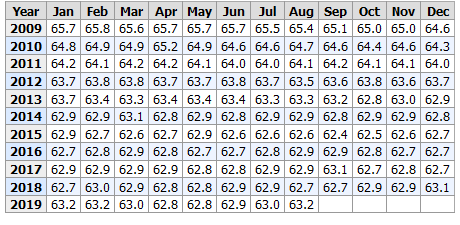As the Democrat presidential candidates continue their debates, all of us need to step back and consider the consequences of economic (and other) policies. For instance, Medicare for all sounds like a really good idea–until you consider that the one place the government has been running healthcare for a while is the Veteran’s Administration. That hasn’t worked too well. Guaranteed income for all also sounds like a great idea–until you begin to calculate how much it will cost. Income inequality is a problem–it is most prevalent in our largest cities that have been under Democrat control for decades. So what has been the result of President Trump’s economic policies?
The Conservative Treehouse posted an article about the current state of the economy.
The article reports:
The Bureau of Economic Analysis (BEA) released significant wage and salary data yesterday which held stunning upward revisions for 2018 and 2019. Wage growth of 5.5% combined with low inflation remaining at 1.4 percent; the disposable income of U.S. workers jumped to a stunning 4.1%.
Within the revised BEA data, we find employee compensation rose 4.5% in 2017 and 5% in 2018. Importantly the growth trend continued into 2019, with compensation increasing 3.4 percent in the first six months alone. Year-over-year wages and salaries were revised upward to 5.3% for May, and 5.5% in June. These are stunning increases in worker pay.
There are various economic indicators we have shared through the years, but wage growth is one of the more critical. First, wage growth lags behind business activity – workers don’t get pay raises until after business volume demands/provides it. Second, wage growth is generally uni-directional – once businesses hike pay, the increases cement.
The wage growth is across the board–it has not impacted only the wealthy.
The article concludes with a summary of President Trump’s overall economic strategy:
The U.S. consumer is driving the economy. The jobs and labor market remains strong. Wage growth is rising in proportion to the diminished availability of the labor pool. Price inflation is low because manufacturing economies (EU and China) are devaluing their currency, and subsidizing their industries (China), in an effort to avoid Trump’s trade policies (tariffs). Their efforts increase the value of the dollar and we are importing deflation.
Simultaneously, global manufacturers -multinationals- need access to the U.S. consumer market. As President Trump applies a series of strategic global trade moves, intended to draw manufacturing back to the U.S., those multinationals are in somewhat of a holding pattern for further investment. Simply, the multinationals are trying to figure out where to put their investment capital for the highest return.
Example: The U.S. economy is strong, unemployment is low and wage rates up; so if China is a non-option, the profit determination shifts. Where to manufacture? It might be more profitable for a multinational in either Southeast Asia or North America. The key is which country has a long-term agreement with the U.S. That’s why the USMCA is critical.
CTH still predicts POTUS Trump will eliminate the uncertainty as soon as the USMCA is ratified. I suspect President Trump will drop massive tariffs on all Chinese goods.
Think of China like a big lake filled with U.S. economic value. Through his Asian discussions with Vietnam, S Korea, Malaysia, Singapore, Australia, Japan, et al, President Trump has stealthily built a thin levy, an ASEAN dam of sorts, that will direct the China lake of economic value into Southeast Asia.
Once the USMCA is signed, Trump will blow the dam by triggering the tariffs. This will move all of the multinationals who are in a ‘holding pattern’, and capital investment will flow fast. The China exodus will benefit North America (USMCA) and those ASEAN nations who have partnered with Trump and made proactive trade agreements.
This is the reason it is good to periodically get politicians out of the White House and elect a successful businessman.


